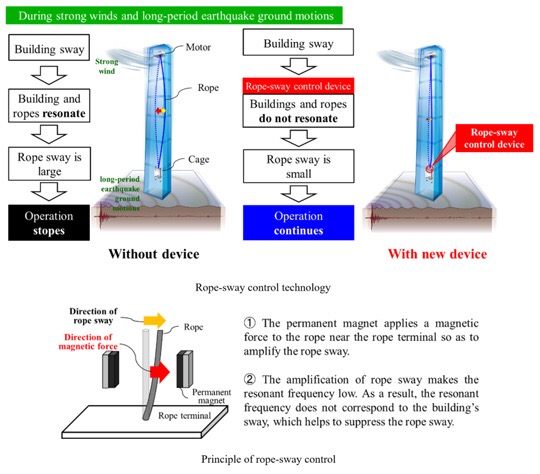
三菱電機:高層エレベーター・ロープ用制震装置を開発 – 風地震時揺れ半減:
MITSUBISHI ELECTRIC:Passive Rope-sway Control Device for Elevators in High-rise Buildings:
三菱电机新闻发布三菱电机为高层建筑电梯开发无源绳索控制装置
三菱電機「ロープ制振装置」:
強風や長周期地震動発生時に起きる高層ビルのエレベーターロープの揺れを抑制する「ロープ制振装置」を開発しました。
ロープの揺れによるエレベーターの運行休止頻度を低減することで安定運行を実現し、利用者の利便性の向上に貢献します。
開発の特長
建物揺れ発生時のロープの揺れを大幅に抑制し、エレベーターの安定運行に貢献
・永久磁石の磁力を利用し、振幅に応じて、乗りかご上部のロープ端末の揺れをあえて増幅
・ロープの共振周波数※1の低下により、建物とロープが共振しにくくなり、ロープの揺れを大幅に抑制
・運行休止頻度が低減し、エレベーターの安定運行に貢献
http://www.mitsubishielectric.co.jp/news/2019/0207-b.html?cid=rss
MITSUBISHI ELECTRIC News Releases Mitsubishi Electric Develops Passive Rope-sway Control Device for Elevators in High-rise Buildings
TOKYO, February 7, 2019 – Mitsubishi Electric Corporation (TOKYO: 6503) announced today that it has developed a device that passively controls rope sway when high-rise building elevator sway due to strong winds or long-period earthquakes.
By enabling elevators to continue operating under such conditions, the new device will help to stabilize elevator operations and contribute to greater user convenience.
Mitsubishi Electric’s new passive rope-sway control device applies a magnetic force, called negative stiffness, to the bottom-end of the rope. Negative stiffness is a well-known principle, and it applies a force in the opposite direction against a normal spring’s restoring force.
Main Features
1)More stable elevator operation by greatly suppressing rope sway when building sways
-The magnetic force of permanent magnets is used to amplify the swing of the rope terminal at the top of the car in accordance with the amplitude.
-Lowering the rope’s resonant frequency, or the frequency at which it tends to sway, makes it difficult for the building and ropes to resonate and thereby drastically curbs rope sway.
-By reducing operational downtime, the device helps to stabilize elevator operations.
2)Successful vibration damping tests on actual elevators
A test that simulated a building swaying due to a long-period earthquake demonstrated that, compared to a rope without a passive rope-sway control device, rope sway could be reduced by at least 55% (magnitude of sway at center of undampened rope = 1).
In a test conducted at Mitsubishi Electric’s “SOLAé” elevator test tower (173 meters high) at Inazawa Works. in Japan, the upper end of a rope was shaken at a frequency simulating the sway of a building due to the long-period ground motion of an earthquake. In the absence of any damping device, rope sway exceeded the company’s recommended threshold for suspending elevator operation. When the damping device was applied, however, rope sway fell below the threshold.
http://www.mitsubishielectric.com/news/2019/0207-b.html?cid=rss